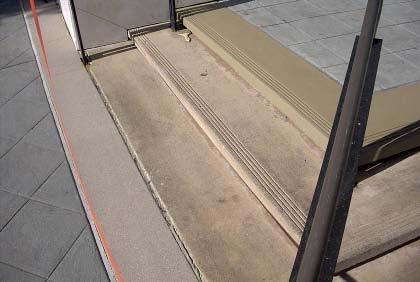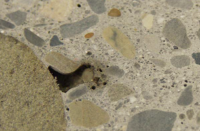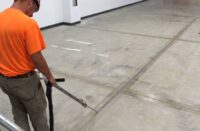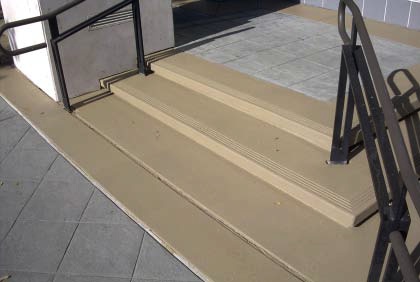Our world is awash in decorative concrete. That’s the good news. The bad news is some of it is looking haggard or worn. This decorative trend can work in favor of those willing to tap a vast and growing market.
Some of you recently made a World of Concrete trip to Vegas and, if you did, you probably noticed two things. One, the WOC decorative concrete presence of the past is all but gone thanks to our ever-growing Concrete Decor Show. Two, Vegas has millions of square feet of decorative concrete in desperate need of recoloring or re-staining.
Most Decor readers are searching. They’re searching for fresh artistic expressions, the latest designs, and the newest tools of our trade. This is why so many make the effort to read Concrete Decor and attend the Concrete Decor Show. They are creative by nature and risk-takers by necessity. Unfortunately, and in part because of this, some of the aforementioned are missing out on a great opportunity. The focus of decorative concrete professionals for 2013 and beyond should be directed toward “redoing” over doing.
We are past the point of simply spraying a fresh coat of sealer in the hope of rejuvenating a tired canvas of concrete.
Many, maybe most, of today’s decorative products are more universal than even manufacturers realize. Research and development within our industry focuses on new applications because up until recently this is where the decorative market was headed. But the process of recoloring or re-staining adds one more challenge: compatibility. This process is our focus today. After all, how can you re-create if the new product application is not compatible with the old one?

How, when and where
Compatibility starts with information. Each project in hope of restoration must first be evaluated. Is the concrete surface sealed? Is there efflorescence? What are the customer’s expectations, at what cost?
I can’t tell you how many calls my office receives where the customer wants to do something to improve her concrete. The first question I ask: “Is your concrete sealed?” The reply, usually: “Yes, but most of the sealer is gone. Can’t you just add some color back?” or “I was thinking about doing it myself but someone gave me your number.”
The art of restoring previously colored or stained concrete is well beyond the capabilities of most homeowners. This is why they need your decorative knowledge and skill. At day’s end it’s all about you and your ability to change drab concrete into something fresh and colorful.
Recoloring unsealed concrete
The right product used over unsealed, yet previously stained or colored, concrete can produce years of outdoor and indoor enjoyment. I personally recommend nonacidic stain products that adhere to the concrete by way of a mechanical bond. These products are very user- and environmentally friendly, not to mention friendly to your customer’s pocketbook.
Water-based, polymer-modified concrete color stains come in solid or translucent options as well as many color choices. Solid stains cover existing discolorations and color fading while adding the beauty of fresh color and sealer all in one application. Translucent polymer-modified stains simulate traditional reactive or acid stains.
I use solid and translucent polymer-modified stains both indoors and out. I’ve found no downside to today’s polymer-modified stain products.
Recoloring sealed concrete
Sealed concrete will complicate a color restoration project. Most manufacturers recommend stripping film-type sealers before adding anything other than new sealer to the concrete’s surface.
Fortunately, many products are now available to remove old sealers. These strippers are effective in removing epoxies, urethanes, paint, acrylics, grease, oil and other coatings that will hinder new color from bonding to the concrete’s surface.
Don’t be afraid to tackle restoration projects previously sealed. I caution contractors against locking themselves into a firm bid when the job includes the removal of a foreign coating. A time-and-material option is best, at least until the concrete canvas is void of all old coatings. Once the coating is removed, an installer should feel comfortable recoloring the fresh canvas.
Selling recoloring projects
Whoever said a picture is worth a thousand words perfectly described color restoration in our industry. It is imperative to use “before and after” photos whenever possible and permitted. A prospective customer can’t visualize the colorful results like you can. They don’t have the experience you have.
Prepare yourself to answer one huge question: “How long will the recolor last?” This is a great question as long as the customer is willing to at least consider throwing more money at a less-than-desirable decorative concrete surface.
For what it’s worth, in five years I’ve never heard a customer request recoloring a polymer-modified stain job. For the record, I haven’t seen a polymer-modified stain color restoration project fail. By fail I mean peel, chip or fade. Surface preparation is important, so be sure to follow the manufacturer’s recommendations to best insure a good bond. I’ve had customers change or dispute the color, but this is a very simple fix when using polymer-modified stain. The fix is as easy as recoating with an alternate color choice. This recoatability is open-ended, at least as long as a foreign coating is not applied to the concrete’s surface, locking the stain underneath.
My recommendation is to find an area of fading concrete to prove how modern stain formulas can restore blah concrete back to a colorful surface.

















